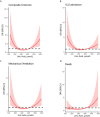Serum Uric Acid Concentrations and Risk of Adverse Outcomes in Patients With COVID-19
- PMID: 34025575
- PMCID: PMC8134697
- DOI: 10.3389/fendo.2021.633767
Serum Uric Acid Concentrations and Risk of Adverse Outcomes in Patients With COVID-19
Abstract
Background: Although hyperuricemia frequently associates with respiratory diseases, patients with severe coronavirus disease 2019 (COVID-19) and severe acute respiratory syndrome (SARS) can show marked hypouricemia. Previous studies on the association of serum uric acid with risk of adverse outcomes related to COVID-19 have produced contradictory results. The precise relationship between admission serum uric acid and adverse outcomes in hospitalized patients is unknown.
Methods: Data of patients affected by laboratory-confirmed COVID-19 and admitted to Leishenshan Hospital were retrospectively analyzed. The primary outcome was composite and comprised events, such as intensive care unit (ICU) admission, mechanical ventilation, or mortality. Logistic regression analysis was performed to explore the association between serum concentrations of uric acid and the composite outcome, as well as each of its components. To determine the association between serum uric acid and in-hospital adverse outcomes, serum uric acid was also categorized by restricted cubic spline, and the 95% confidence interval (CI) was used to estimate odds ratios (OR).
Results: The study cohort included 1854 patients (mean age, 58 years; 52% women). The overall mean ± SD of serum levels of uric acid was 308 ± 96 µmol/L. Among them, 95 patients were admitted to ICU, 75 patients received mechanical ventilation, and 38 died. In total, 114 patients reached composite end-points (have either ICU admission, mechanical ventilation or death) during hospitalization. Compared with a reference group with estimated baseline serum uric acid of 279-422 µmol/L, serum uric acid values ≥ 423 µmol/L were associated with an increased risk of composite outcome (OR, 2.60; 95% CI, 1.07- 6.29) and mechanical ventilation (OR, 3.01; 95% CI, 1.06- 8.51). Serum uric acid ≤ 278 µmol/L was associated with an increased risk of the composite outcome (OR, 2.07; 95% CI, 1.18- 3.65), ICU admission (OR, 2.18; 95% CI, 1.17- 4.05]), and mechanical ventilation (OR, 2.13; 95% CI, 1.06- 4.28), as assessed by multivariate analysis.
Conclusions: This study shows that the association between admission serum uric acid and composite outcome of COVID-19 patients was U-shaped. In particular, we found that compared with baseline serum uric acid levels of 279-422 µmol/L, values ≥ 423 µmol/L were associated with an increased risk of composite outcome and mechanical ventilation, whereas levels ≤ 278 µmol/L associated with increased risk of composite outcome, ICU admission and mechanical ventilation.
Keywords: COVID-19; U-shape; adverse outcome; relationship; uric acid.
Copyright © 2021 Chen, Lu, Gu, Li, Zhang, Lio, Luo, Zhang, Hu, Lan, Chen, Xie and Pan.
Conflict of interest statement
The authors declare that the research was conducted in the absence of any commercial or financial relationships that could be construed as a potential conflict of interest.
Figures


Similar articles
-
Serum uric acid, disease severity and outcomes in COVID-19.Crit Care. 2021 Jun 14;25(1):212. doi: 10.1186/s13054-021-03616-3. Crit Care. 2021. PMID: 34127048 Free PMC article.
-
Prevalence and outcomes of atrial fibrillation in patients hospitalized with COVID-19.Curr Med Res Opin. 2024 Sep;40(9):1477-1481. doi: 10.1080/03007995.2024.2378179. Epub 2024 Jul 26. Curr Med Res Opin. 2024. PMID: 39034775
-
Digestive system involvement and clinical outcomes among COVID-19 patients: A retrospective cohort study from Qatar.World J Gastroenterol. 2021 Dec 14;27(46):7995-8009. doi: 10.3748/wjg.v27.i46.7995. World J Gastroenterol. 2021. PMID: 35046626 Free PMC article.
-
Predictors of adverse prognosis in COVID-19: A systematic review and meta-analysis.Eur J Clin Invest. 2020 Oct;50(10):e13362. doi: 10.1111/eci.13362. Epub 2020 Aug 27. Eur J Clin Invest. 2020. PMID: 32726868
-
Effect of increased BMI and obesity on the outcome of COVID-19 adult patients: A systematic review and meta-analysis.Diabetes Metab Syndr. 2020 Nov-Dec;14(6):1897-1904. doi: 10.1016/j.dsx.2020.09.029. Epub 2020 Sep 28. Diabetes Metab Syndr. 2020. PMID: 33007661 Free PMC article.
Cited by
-
Uric acid as a prognostic factor and critical marker of COVID-19.Sci Rep. 2021 Sep 7;11(1):17791. doi: 10.1038/s41598-021-96983-4. Sci Rep. 2021. PMID: 34493750 Free PMC article.
-
Shared genetic influences between blood analyte levels and risk of severe COVID-19.Cell Rep. 2022 Nov 22;41(8):111708. doi: 10.1016/j.celrep.2022.111708. Epub 2022 Nov 7. Cell Rep. 2022. PMID: 36400032 Free PMC article.
-
The predictive significance of uric acid to high density lipoprotein- cholesterol ratio and uric acid for the severity and mortality of coronavirus disease-19.BMC Res Notes. 2024 Sep 27;17(1):277. doi: 10.1186/s13104-024-06807-7. BMC Res Notes. 2024. PMID: 39334249 Free PMC article.
-
Altered Serum Uric Acid Levels in Kidney Disorders.Life (Basel). 2022 Nov 15;12(11):1891. doi: 10.3390/life12111891. Life (Basel). 2022. PMID: 36431026 Free PMC article. Review.
-
Inflammation Related to Association of Low Uric Acid and Progression to Severe Disease in Patients Hospitalized for Non-Severe Coronavirus Disease 2019.Biomedicines. 2023 Mar 10;11(3):854. doi: 10.3390/biomedicines11030854. Biomedicines. 2023. PMID: 36979833 Free PMC article.
References
-
- WHO . Coronavirus Disease 2019 (COVID-19) Situation Report –179 (2020) (Accessed by July 18, 2020).
Publication types
MeSH terms
Substances
LinkOut - more resources
Full Text Sources
Other Literature Sources
Medical
Miscellaneous

